-
12
Description: Rectangular; twisted rope edging on top and sides; inscription panel with repeated trailing vine decoration from impressed wooden strips — one horizontal line at top, one vertical strip on right side (missing but probably repeated on left), at least ten short vertical strips below inscription.
Notes: Formerly at Fulling Mill Cottages, and possibly formerly at Wakehurst Place, Ardingly; it was moved to Ardingly church sometime after 1915. The inscription panel is identical to that on the memorial plate to Anne Forster in Crowhurst church, Surrey; at least ten other firebacks are known with the same inscription panel. Edward Culpeper (1561-1630), of Wakehurst, was fourth cousin, once removed, of Anne Forster. Assuming the vine strip and rope edging on the left side were of approximately the same width as on the right the overall original width of the fireback is estimated to have been 837mm.
Inscription: HER : LIETH : ANE : FORST/ R : DAVGHTER : AND : / HEYR : TO : THOMAS : / GAYNSFORD : ESQVIER / DECEASED : XVIII : OF: / IANVARI : 1591 : LEAVYNG / BEHIND : HER II : SONES : / AND : V : DAVGHTERS
- Decoration tags:
- rectangular (shape)
- rope (edging)
- carved stamps
- carved pattern panels
- planklines
- text
- plants
Manufactured: in the late-16th century possibly at Pounsley Furnace, Framfield in the Weald area of England.
Current location: St Peter's Church, Church Lane, Ardingly, West Sussex, England.
Citation: Holgate, M. S., n.d., The Parish Church of St Peter, Ardingly: Historical and Architectural Notes.
-
876
Description: Canted rectangle; complex moulded edging (top and sides); rectangular incised initial stamp repeated ten times 3-4-3.
Notes: The use of an incised stamp is uncommon.
Inscription: RTI [repeated 10 times]
- Decoration tags:
- rectangular with canted top corners (shape)
- complex individual (edging)
- carved stamps
- text
Manufactured: in the 17th century in England.
Current location: Westwood Manor, Bradford-on-Avon, Wiltshire, England.
Museum number: 222509.1 (part of the National Trust museum group)
- Attached to series:
- Initials only firebacks
- Miscellaneous stamp firebacks
-
933
Description: Carved wooden fireback pattern. Arched rectangular shape with fillet and cavetto-moulded edging; a canopy with swagged drapery descending from ribbon bunches, beneath which stand two figures: behind, a female angelic figure, right breast exposed, blowing a trumpet held in her left hand and holding an arched rectangular shield in her right hand; in front, a classically dressed male figure wearing a face mask; slatted extensions to the side and bottom; two battens to the rear of the pattern, visible at the top.
Notes: The significance of the scene has not been identified. Christie's auction 3 Jul 2002 lot 160 (£588).
- Decoration tags:
- rectangular with round arch (shape)
- fillet (edging)
- whole carved pattern
- planklines
- pictorial
- architectural
- humans
Manufactured: in the mid- to late-18th century in France.
Current location: not known.
- Attached to series:
- Patterns
-
268
Description: Rectangular; cavetto moulded edging; shield, garter, coronet, helm, crest, supporters and motto of Villiers, 1st Duke of Buckingham.
Notes: The arms are those of George Villiers (1592-1628), created Duke of Buckingham in 1623. Blazon: Quarterly 1, Villiers (modern) - argent, on a cross gules five scallops or; 2, Villiers (ancient) - sable, a fess between three cinquefoils argent; 3, Pakeman - gules, a chevron between three crosses botonnee fitchee argent; 4, Bellers - per pale gules and sable, a lion rampant argent crowned or; 5, Hoby - azure, a bend between six mullets argent; 6, Kirkby - argent, a cross between two annulets vert.
Copies of this fireback are known.
Inscription: HONI SOIT QVY MAL Y PENSE / FIDEI COTICULA CRUX [The cross is the touchstone of faith]
Arms: George Villiers, 1st Duke of Buckingham
- Decoration tags:
- rectangular (shape)
- cavetto (edging)
- whole carved pattern
- planklines
- armorial
Manufactured: in the early-17th century in England.
Current location: not known.
Citation: Dawson, C., 1903, 'Sussex Iron Work and Pottery', Sussex Archaeological Collections, 46, pp. 1-54.
- Attached to series:
- Personal armorial firebacks
- Bristol armorial group
-
1051
Description: Rectangular with triangular arch; ovolo-moulded edging (top and sides); small stamp of a ‘Renaissance’ shield bearing the initials IC, repeated eight times 3-2-3) in a regular arrangement.
Notes: The initials have not been identified.
Inscription: IC
- Decoration tags:
- rectangular with triangular arch (shape)
- ovolo (edging)
- carved pattern panels
- heraldic
- text
Manufactured: in the mid- to late-16th century in the Weald area of England.
Current location: not known.
- Attached to series:
- Initials only firebacks
- Triangle arch series
-
70
Description: Arched rectangular shape; simulated twisted rope edging (top & sides); symmetrical arrangement of fleurs de lys (two types - 2 and 1), diamond shapes (2) and cross-cut squares (4) includes the monogram in which the letters I and F are separated by a small, hollow diamond stamp, the M being above; interspersed symmetrical arrangement of raised spots (8).
Notes: The initials, as with other triple-lettered forms, in which the middle letter is set apart from the other two, may relate to a married couple where their surname initial is M. Another example seen has shown that the pattern was formed of five angular, uneven-sized planks battened together.
Copies of this fireback are known.
Inscription: 1613 / M / I F
- Decoration tags:
- rectangular with round arch (shape)
- simulated rope (edging)
- simple stamps
- carved stamps
- individual letters
- individual numbers
- planklines
- heraldic
- text
Manufactured: in 1613 in the Weald area of England.
Current location: Godalming Museum, Godalming, Surrey, England.
Museum number: B980.400 (part of the Godalming Museum museum group)
- Attached to series:
- Diamond series
-
882
Description: Arched rectangular shape; simulated twisted rope edging (top & sides); symmetrical triad arrangement of fleurs de lys (two types - 2 and 1), diamond shapes (2) and cross-cut squares (4) includes the monogram in which the letters I and F are separated by a small, hollow diamond stamp, the M being above between I and reversed B; interspersed symmetrical arrangement of raised spots (8).
Notes: The initials, IMF, as with other triple-lettered forms, in which the middle letter is set apart from the other two, may relate to a married couple where their surname initial is M; a variant of the more common version but with additional letters I and B separately stamped. Life-size pencil drawing (anon.) in Historic England Record Centre, Swindon, Wiltshire (MD96/06202) of a fireback originally at 124 Heath Street (formerly the Upper Flask Tavern), Hampstead, London.
Inscription: 1613 / I M B / I F
- Decoration tags:
- rectangular with round arch (shape)
- simulated rope (edging)
- carved stamps
- carved pattern panels
- individual letters
- individual numbers
- heraldic
- text
Manufactured: in 1613 in the Weald area of England.
Current location: not known.
Museum number: MD96/06202 (part of the Historic England museum group)
- Attached to series:
- Diamond series
-
118
Description: Rectangular with triangular pediment; stepped fillet and ogee moulded edge; initials in rectangular panel (F reversed); date in portico.
Notes: The triangular top is a separate element, in this instance impressed before the lower panel. A variant at the Victoria and Albert Museum (no. 771) has the letters positioned slightly differently. A version of this fireback, with a rope-edged panel in the lower part, and medallion stamps, can also be seen at Hastings. Formerly part of the Ade Collection (from Grove Hill, Hellingly, Sussex).
Inscription: 1586 F M
- Decoration tags:
- triangular arched (shape)
- stepped fillet and ogee (edging)
- individual letters
- date stamp
- text
Manufactured: in 1586 in the Weald area of England.
Current location: Hastings Museum and Art Gallery, John's Place, Bohemia Road, Hastings, East Sussex, England.
Museum number: HASMG: 1952.51.58 (part of the Hastings Museum museum group)
Citation: Lloyd, N., 1925, 'Domestic Ironwork I', Architectural Review, 58, pp. 58-67.
- Attached to series:
- 1586 series
-
171
Description: Quasi-rectangular with raised symmetrical scrolls between semi-circular re-entrants on top edge; ovolo-moulded edge on bottom and sides, with fillet edging on top; grotesque face with swirled hair locks, above an inverted floral spike, between two moustachioed male figures in tunics, holding pikes, standing on a cavetto-moulded compartment, date beneath.
Notes: Alleged to represent the 'Brede Ogre', Sir Goddard Oxenbridge (1478-1531) who, legend states, was sawn in half by local children. Stylistically similar to other firebacks with connections with Brede furnace.
Copies of this fireback are known.
Inscription: 16 52
- Decoration tags:
- rectangular with ornate arch (shape)
- fillet (edging)
- whole carved pattern
- individual numbers
- pictorial
- text
- humans
Manufactured: in 1652 probably at Brede Furnace in the Weald area of England.
Current location: Hastings Museum and Art Gallery, John's Place, Bohemia Road, Hastings, East Sussex, England.
Museum number: HASMG: 1924.42 (part of the Hastings Museum museum group)
Citation: Baines, J. M., 1958, Wealden Firebacks (Hastings Museum).
Citation: Butterfield, W. R., 10 Mar 1934, 'The Brede Ogre', Hastings and St Leonards Observer.
- Attached to series:
- Hooked '1' series
- Brede group
-
836
Description: Rectangular with triangular arch; ovolo-moulded edging (top and sides); small stamp of a quartered shield with helm, crest and mantling above the date '1571, initials split either side of shield, repeated six times in two lines of three, the middle stamp of each line higher than the other two.
Notes: The arms may be of the family of Humberston quartered with another; the stamp would have been made specially for the fireback, the date and initials being carved with the arms.
Inscription: I H / 15 71 [repeated 6 times]
Arms: Humberston family
- Decoration tags:
- rectangular with triangular arch (shape)
- ovolo (edging)
- carved stamps
- armorial
- text
Manufactured: in 1571 in the Weald area of England.
Current location: Christchurch Mansion, Ipswich, Suffolk, England.
(part of the Colchester & Ipswich Museums Service museum group)
Citation: Traill, H. D. & Mann, J. S., 1902, Social England vol. III, (London, Cassell), p. 732.
- Attached to series:
- Personal armorial firebacks
- Triangle arch series
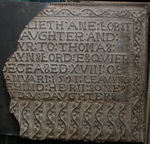
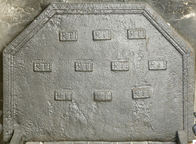
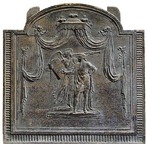
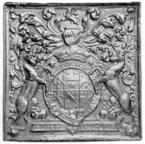
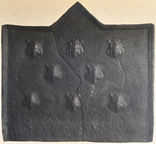
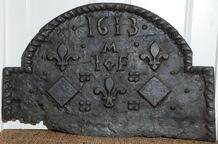
.jpg)


